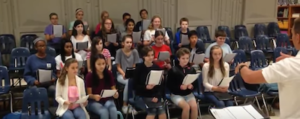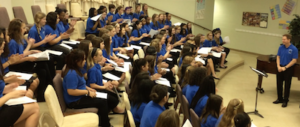“Why won’t my middle school choir sing?”
I saw the above comment a while back on a Facebook Music Group, and it reminded me of my early years of teaching this very unique age group.
It’s frustrating, and I believe it’s quite commonly experienced in middle school choral classrooms across America.
You ask yourself, “Why are these kids in choir if they don’t want to sing?!”
They are sitting in your room taking up the air space, but contributing nothing. It’s a terrible feeling to try to teach singing to children who won’t sing.
What do you do about it? How do you fix it? Should you threaten to lower their grade? Should you call their parents?
Before I share how and why I think some middle school teachers face this scenario, you need to be prepared! The answers aren’t easy to hear.
After having faced this scenario in my own middle school classroom, I had to do some deep soul searching that included all of the items I share in this article. I’ve been through this, and I survived! So can you!
The good news is that there ARE solutions to this scenario and many of those ideas will help grow your middle school program in many ways in addition to helping you get your children to sing! The changes will take time, but we can cause positive change to occur and begin working toward having a classroom of motivated students who want to sing and who enjoy the process of learning.
So, here is what I believe is the answer to why the children won’t sing.
It’s our fault.
Ouch.
It’s difficult to hear, but when I, myself, decided to take responsibility for the lip-syncing, unmotivated middle school children who were sitting in front of me each day, everything began to change, and it is the reason that I am still teaching today.
Ok…now that’s over.
What are some ideas that will help us make this experience a thing of the past?
During my 23 years teaching, I’ve heard all sorts of reasons for why middle school choir programs often struggle. In this article, I’m going to share some of those common reasons in hopes that I might help other choir teachers work toward solutions so they can create a positive learning environment in which your children not only WANT to sing, but can’t WAIT to sing.
Reason #1:
They don’t understand the information.
It took me a while to realize how little my middle school students knew when they walked into my door at the beginning of the year. Most of my students come from strong elementary feeder programs, but most have had music only two times a week for 30 minutes during that time. It is not possible to teach the details that I was expecting of my students in that amount of time.
I needed to change my expectations and meet them where they were when they arrived. I needed to work to find fun, interesting ways to deliver the material to that they not only learned it, but enjoy the process of learning it.
In the early days of my career, I’d hand them a piece of music and they would look at the page with complete puzzlement. I failed to recognize it, and I’d get frustrated with them and say “Why isn’t anyone singing?!? If you don’t sing, I’m going to go down the line and make you sing by yourself!”
Well, I quickly learned that certainly doesn’t inspire anyone to want to sing.
I realized that most of them didn’t have any idea what a staff or system or measure is. Sing alto? What’s that? Sing forte? What is that and how am I supposed to know when or how to do it without singing out of tune?! It became clear that most of them were simply following the words, and even THAT didn’t make sense because, when they were looking at a 2-part or 3-part piece, they didn’t understand where to go when they reached the last measure of a system. …Not to mention the fact that many 6th graders not only don’t understand how to follow a score, but also, many of them still struggle with basic reading skills. They can’t even read most of the words! …Especially when the words are written like this:
To-mor-row is go- ing to be a bea- ti- ful day.
And I had the audacity to ask why no one was singing?
Recognizing and empathizing with what our beginning middle school students don’t know is so very important. Here is an analogy: When they look at a 2 or 3 part piece of music that includes dots, curved lines, fractions, grids and symbols they don’t recognize, they feel the same we would feel if someone asked us to read aloud a book that is written in Arabic.
It’s a vicious cycle, and the only way to break it is to teach them one concept at a time steadily, creatively and deliberately each and every day and to do it in a way that they thrive and enjoy the process of learning.
Does that mean you might teach from rote sometimes? Sure! We must. Four year old children can speak and use words that they cannot possibly write or define. It’s the same for beginning singers.
Next Saturday, I’ll post reason #2!
Dale Duncan
From the creator of S-Cubed Middle School Sight Singing Program for Beginners
Click here to go to my YouTube channel!




Seth Boyd says
This is a good point, Dale. However, while you identified the problem your solutions were a bit vague. I would be interested to hear your creative solutions to teaching these skills, along with anyone else who has tried teaching score reading to middle school students.
Andrey Luchnik says
I agree with Seth Boyd.
“score reading” must be not only frequency of sound properly uttered, but natal language (English) sound, devoid of Latinism disfigure and distort.